Raise your hand if you’ve never daydreamed about Provence, that land caressed by the sun and enlivened by the song of cicadas which, with its bright colours, has always beguiled countless artists.
To take you on a journey to discover the marvels of this corner of Europe, I’ve selected three unmissable places in Provence that, in my opinion, will captivate you with their legends, their flavours and fragrances, the vibrant colours of nature, and the myriad paths that intersect them.
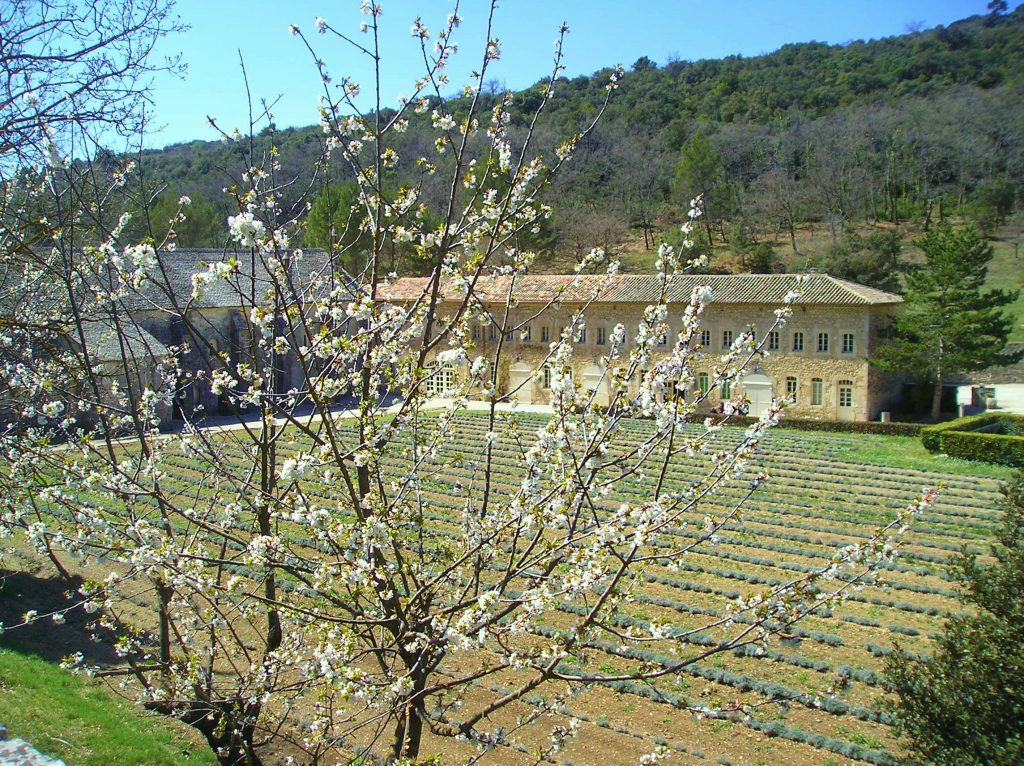
Sénanaque Abbey
1)ROUSSILLON and Provençal COLORADO – Unmissable places in Provence
The colours of Provence
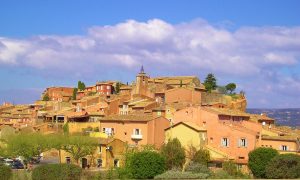
Roussillon
First on my list is Roussillon, a charming small town in the north of the Luberon, which has rightfully earned its place among the most beautiful villages in France. As you explore its streets, you’ll be dazzled by the vividness of the multiple shades of red that grace every house and wall. This remarkable display is attributed to the abundant ochre deposits found in the area. These deposits were historically transported to Marseille and then shipped to Rome, where they were used to dye the robes of senators. With just over 1,300 residents, Roussillon is a true gem nestled on the Vaucluse plateau.
.
Artists inspired by Provence
After the conclusion of World War II, Roussillon became a magnet for acclaimed artists who were captivated by the luminosity of the southern region of France. Notable figures such as painters Cocteau and Chagall, along with playwright Beckett, who is said to have found inspiration here for his renowned work ‘Waiting for Godot’, were drawn to this artistic haven.
The landscape itself is undeniably captivating, leaving a lasting impression on all who encounter it. As we depart from the village, we make a stop at the old ochre mines, known as Les Sentiers des Ocres, which have been whimsically bestowed with names from the realms of fantasy and fairy tales by popular imagination. It is impossible to resist the temptation of immersing oneself in a landscape adorned with cliffs, sand dunes, and an array of towering formations, each bearing enchanting monikers such as the ‘Valley of the Fairies’ or the ‘Walk of the Giants’.
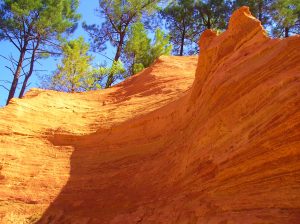
Towering formations
Myths and legends in Provence
The captivating legends that surround these geological formations in Provence are a product of the interplay between nature and the rich tapestry of popular imagination. These tales intertwine the awe-inspiring landscapes with the creative narratives woven by the collective consciousness. Among these stories is the belief that the fiery red hue of the earth resulted from the Titans hurling flames in their vengeful quest to conquer these lands.
Another widely embraced legend, famously depicted in Boccaccio’s Decameron, tells the tale of ill-fated love that echoes through the ages. As we embark on our holiday in Provence, it is the perfect opportunity to immerse ourselves in these captivating myths and embrace the literary treasures they hold.
The tragic tale of Sermonde
Guilhem de Cabestang, a younger son of a squire from Apt, known for his love of art and literature, enters the service of Count Guilhem of Roussillon as a troubadour. The count is married to the enchanting Sermonde. Despite the ideals of courtly love, Guilhem and Sermonde succumb to an intense and forbidden passion. However, as is often the case within courtly circles, gossip spreads, and the Count becomes aware of their affair, vowing to exact revenge. Under the pretense of a hunting match, the Count lures Guilhem to his demise, mercilessly slaying him with a sword.
Unsatisfied with mere bloodshed, the Count proceeds to carve open Guilhem’s chest, extracting his heart. Returning to the castle, he commands the cook to prepare a dish using the stolen organ, intending to serve it to his unfaithful wife. Oblivious to the sinister truth, Sermonde devours the meal with relish, only discovering the horrifying reality as her husband taunts her with sadistic satisfaction: “It could not be otherwise! It is only natural for those whom you adored in life to also be pleasing to you in death.” Upon hearing these words, poor Sermonde rises from the table in despair, rushing towards the highest tower of the castle. At its summit, consumed by anguish, she plunges into the abyss below.
Legend tells that the surrounding rocks turned crimson from the mingling of her blood and that of her ill-fated lover. However, the less romantic belief attributes the reddish hue to the presence of iron oxides, resulting from the oxidation of iron within the seabed’s sandy deposits. Centuries ago, long before Provence emerged, the region was submerged beneath the sea.
Rustrel Colorado
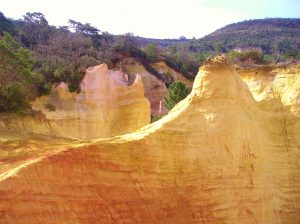
Provençal Colorado
Just a few kilometres from Apt, a serene town nestled in the heart of Provence, lies a site that, in my opinion, is even more grandiose and spectacular than the previous one.
It is the Colorado Provençal or Colorado of Rustrel, named after the village that hosts it. It is the site of the old ochre mines and can be discovered at one’s own pace by following the marked trails.
If the locals like to call this site Colorado, perhaps because of the sense of disorientation it produces in those who visit it, certain elements distinguish it from the Grand Canyon of the United States. Apart from the lush vegetation that surrounds it, the colour palette here is much more varied than at the American site; painters count as many as 20 different shades ranging from mustard to indigo.
Strolling from pinnacle to pinnacle and up and down the dunes through valleys of white sand (one of them has been christened Sahara), one amuses oneself by imagining phantasmagorical shapes modelled over the centuries by the action of wind and erosion.
2) GORDES, VILLAGE DES BORIES – Unmissable places in Provence
The troglodyte village
It is a challenge to determine which among the villages of Luberon is the most exquisite, as this region boasts a wealth of history and awe-inspiring landscapes in the heart of Provence. However, according to the esteemed commission responsible for bestowing the label ‘Les plus beaux villages de France,’ Gordes claims its rightful
Nestled on the slopes of the Plateau de Vaucluse, Gordes offers a commanding view from its elevation of 400 metres, overseeing a picturesque panorama adorned with vineyards and olive groves imparting a profound sense of serenity to the discerning traveller or tourist.
The village captivates the gaze from a distance, as the sunlight elegantly dances upon the immaculate white stones that embellish its buildings. Atop the summit, the imposing castle, originally built in the 11th century and extensively restored during the Renaissance era, now serves as a distinguished venue for art exhibitions
However, Gordes harbours a hidden life, concealed from the casual observer. Beneath the Palais Saint-Firmin, lies a labyrinthine network of caves and subterranean chambers, forming a veritable troglodyte village replete with artisans’ workshops, where remnants of a bread oven and even an oil mill can still be found. It was within these underground sanctuaries that the resilient inhabitants of Gordes sought refuge during the tumultuous wars and sieges that beset the region in bygone eras.
Are you a devotee of ancient villages? If you find yourself basking in the splendour of Provence during your holiday, the enchantment of other unmissable places in Provence will undoubtedly captivate your spirit Exploring the hidden gems of Provence
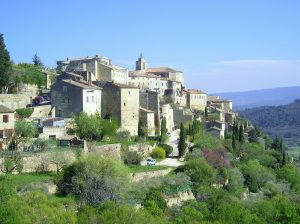
Gordes
Life in the Fields
Situated just four kilometres from Gordes, in a charming hamlet named Les Cabanes, lies the fascinating Villages des Bories.
The Bories, derived from the Latin term Bovaria, meaning oxen barn, are intriguing cone-shaped structures believed to have been erected using the dry construction technique during the 17th century.
Between the 17th and 18th centuries, the population growth had led to insufficient cultivable land; therefore, it was necessary to acquire and clear uncultivated and infertile plots. It was the extracted limestone stones from the fields that provided the necessary material for building the bories.
But what were they used for? Over the centuries, they served various purposes: dwellings and shelters for the farmers, stables for livestock, and even baking ovens. The Village des Bories is a genuine museum of village life and an opportunity to discover the customs and traditions of the Provençal farmers of past centuries.
3) SENANQUE ABBEY
Lavender and Historic Abbeys
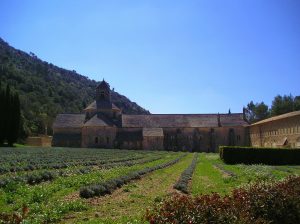
Senanque Abbey
A visit to one of the most renowned Cistercian abbeys in the south of France, the Abbey of Sénanque, nestled in a lush valley and surrounded by fragrant lavender fields, is a must before concluding your holiday in Provence. This austere monastic complex dates back to the 12th century and stands out for its simplicity and sobriety, characteristic of the rule of Saint Benedict.
You will also find the Meraviglieuropa travel blog on:
Facebook: Meraviglieuropa
Instagram: Veronica.Meraviglieuropa
Pinterest: Meraviglieuropa


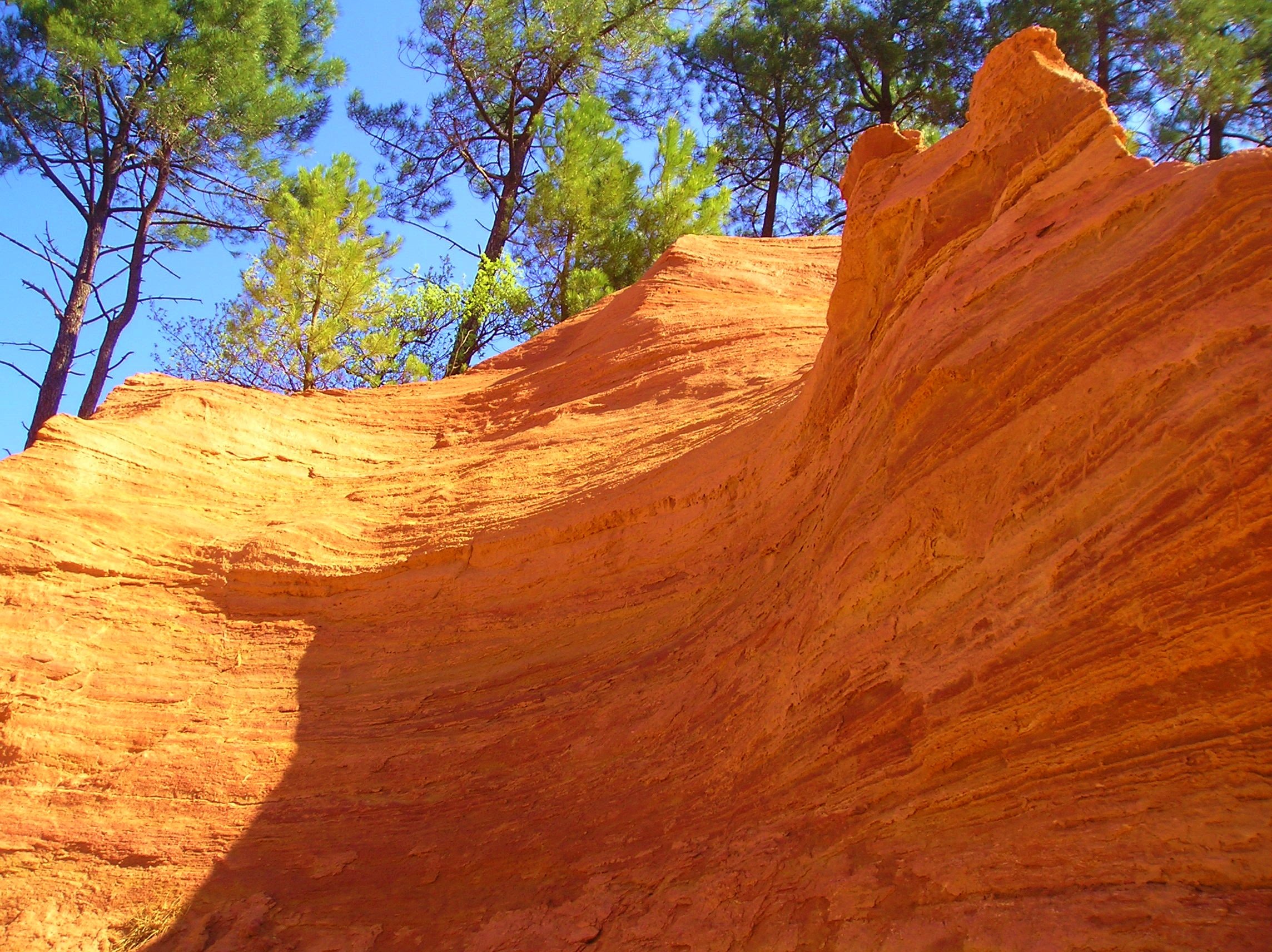



No responses yet